


Reliability is a metric used to indicate the fraction of sources listed in the AllWISE Source Catalog that are real astrophysical sources. While there are no formal reliability requirements placed on the AllWISE Source Catalog, we use those placed on the WISE All-Sky Source Catalog to judge the quality of the AllWISE catalog.
In that regard, the analysis proceeds identically to that used for the All-Sky release, with the exception that we use only the comparison to Spitzer data for the AllWISE catalog. The data sets needed to perform the internal comparison were not produced for the AllWISE release, and the 2MASS comparison is of limited informational value by the comparatively low completeness limit of 2MASS and the presence of a fair number of high proper motion sources coupled with the decade between the surveys. Thus the AllWISE reliability analysis focuses on the use of Spitzer data as the truth table. Because the analysis is identical, please refer to the All-Sky Release Catalog reliability summary for a description of the requirements, how they are interpreted, and how the data are plotted.
Based on the comparison of AllWISE sources to those catalogued by Spitzer in 10 selected fields, the AllWISE Source Catalog also meets the 99.9% reliability requirement for sources with SNR ≥ 20 in at least one band.
The comparison between AllWISE and Spitzer sources used 10 of the same 11 fields used in the analysis of the All-Sky Release Catalog comparison. Rho Oph was not included due to the fact the nebulosity makes any reliability calculation relatively indeterminate. Please refer to section VI.6.c of the All-Sky Release Explanatory Supplement for the details of the analysis.
We again begin with the seven fields from the SWIRE and COSMOS surveys. These fields are dominated by stars and galaxies, the areal density is rather low, and there is little extended emission present, thus they represent a relatively benign test of the catalog extraction algorithms. Each field is typically a few square degrees and, thanks to the greater depth of coverage of the AllWISE Catalog, has from 30,000 to over 140,000 sources contained within it.
An automated first pass matching Spitzer sources to AllWISE source shows very good results for the COSMOS field in Figure 1. The requirement is nearly met, but it is clear a few bright AllWISE sources had no Spitzer counterpart.
An interactive search using Spitzer image cutouts was performed for those sources that were not matched. Nearly all missing sources that were searched (w1snr ≥ 15, w2snr ≥ 12, w3snr ≥ 10, or w4snr ≥ 10) were in fact recovered. Like the All-Sky Catalog, the recovered sources were "pathological" binaries or multiples, or components of a resolved galaxy (Figure 2).
Figure 3 shows the reliability results for the COSMOS field after a second pass through the matching step after these sources have been confirmed to exist by eye. Pulling in these missed sources show that the reliability metric is easily met for the COSMOS files.
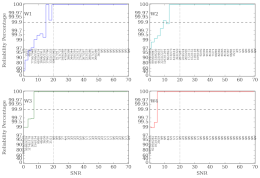 |
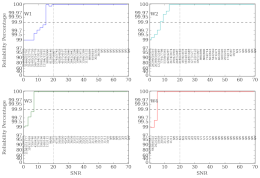 |
| Figure 3a - Differential reliability for the COSMOS field after interactive source recovery. | Figure 3b - Cumulative reliability for the COSMOS field after interactive source recovery. |
The results show that 100% of the WISE sources with SNR ≥ 20 in the COSMOS field have matching Spitzer entries, when multiplicity and extended source emission are taken into account.
In looking at the ELAIS-N1 field, the results are not as promising after the first pass. There are a fair number of unmatched sources with SNR of 30-50 in all wavelength bands.
Interactive examination again found that most of these unmatched sources were binaries or galaxies, but a few of them (especially the bright ones) were AllWISE sources that fell into gaps in the Spitzer coverage, particularly if the bright source was near an overwhelmingly brighter source; the Spitzer catalogs must have rejected such objects as halo artifacts. These sources were dropped from the statistics. (That is, if the first pass says "m out of n sources were matched", finding a binary/galaxy component lets one say "m+1 out of n sources were matched", while dropping a gap source is equivalent to "m out of n-1 sources were matched".) After such matching, nearly all sources are identified, and the corrected plots (Figure 5) show that 99.9% reliability is easily achieved.
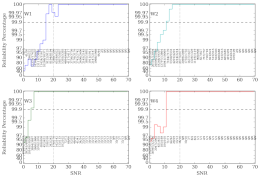 |
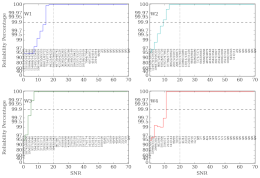 |
| Figure 5a - Differential reliability for the ELAIS-N1 field after interactive source recovery. | Figure 5b - Cumulative reliability for the ELAIS-N1 field after interactive source recovery. |
The other five extragalactic fields produce similar results and are shown without further comment at the end of this page for completeness.
To investigate the effect of very red sources and nebulosity on the reliability, 3 of the 5 regions from the Spitzer C2D CLOUDS surveys were also analyzed (Chamaeleon, Perseus, and Serpens; the Lupus patches are too small to yield good statistics and the Ophiuchus area is too contaminated by bright nebulosity as noted above). The AllWISE search regions were limited to those areas within the Spitzer surveys that had the deepest coverage. Unlike the extragalactic fields where nearly 100% of the Spitzer area could be searched for matches to WISE, the SFRs had much less uniform coverage, so the fraction of each area that could be searched is much smaller, as is demonstrated in the maps.
Figure 6 shows the first pass results for the Chamaeleon region. The preliminary reliability is again quite good.
Figure 7 shows the equivalent plots after hand-matching, showing once again that the reliability criteria are well met. However, as for the All-Sky catalog, there is a very important caveat: because the AllWISE catalog is also a "source catalog", not a "point source catalog", not all the matched sources are point sources. Because AllWISE will classify denser knots of nebulosity as sources, follow-up observations at other facilities are unlikely to produce the intended results, and such fields should be checked carefully prior to such observations.
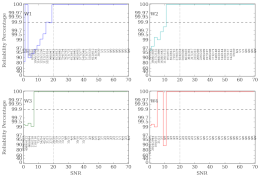 |
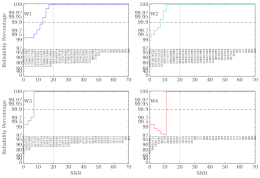 |
| Figure 7a - Differential reliability for the Chamaeleon field after interactive source recovery. | Figure 7b - Cumulative reliability for the Chamaeleon field after interactive source recovery. |
Perseus and Serpens show similar behavior, and are therefore left to the end of this page along with the supplemental extragalactic fields.
In summary, the COSMOS, SWIRE, and CLOUDS fields demonstrate that deep Spitzer fields are extremely effective truth tables and that the reliability of the AllWISE source extractions is very good when the differences in spatial resolution between AllWISE and Spitzer are properly taken into account, as well as the fact that AllWISE is a source catalog, not a point source catalog. The 99.9% reliability requirement for sources with SNR ≥ 20 in any band is confirmed.
Reliability plots for the seven regions not discussed above are presented without further comment. All support the reliability conclusions reached in the main body of the text.
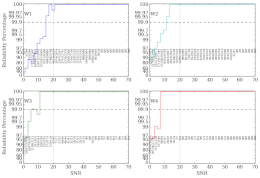 |
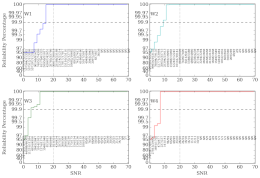 |
| Figure 9a - Differential reliability for the CDF-s field after interactive source recovery. | Figure 9b - Cumulative reliability for the CDF-s field after interactive source recovery. |
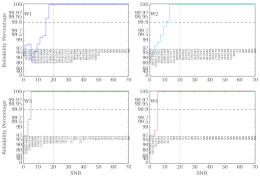 |
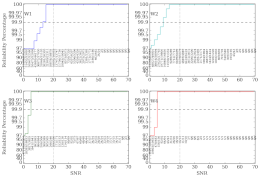 |
| Figure 11a - Differential reliability for the ELAIS-N2 field after interactive source recovery. | Figure 11b - Cumulative reliability for the ELAIS-N2 field after interactive source recovery. |
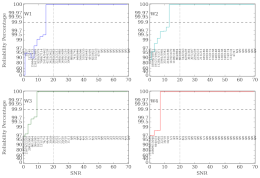 |
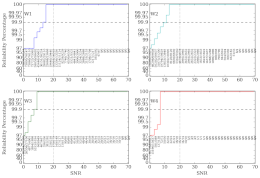 |
| Figure 13a - Differential reliability for the ELAIS-S1 field after interactive source recovery. | Figure 13b - Cumulative reliability for the ELAIS-S1 field after interactive source recovery. |
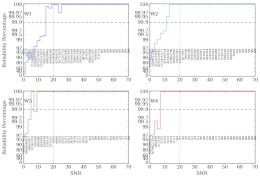 |
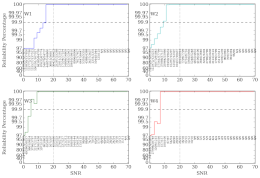 |
| Figure 15a - Differential reliability for the Lockman field after interactive source recovery. | Figure 15b - Cumulative reliability for the Lockman field after interactive source recovery. |
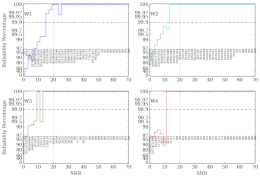 |
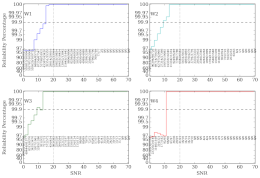 |
| Figure 17a - Differential reliability for the XMM field after interactive source recovery. | Figure 17b - Cumulative reliability for the XMM field after interactive source recovery. |
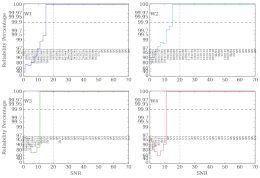 |
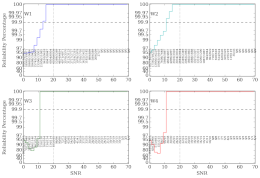 |
| Figure 19a - Differential reliability for the Perseus field after interactive source recovery. | Figure 19b - Cumulative reliability for the Perseus field after interactive source recovery. |
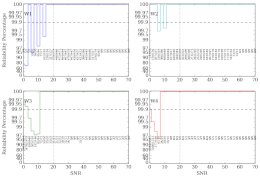 |
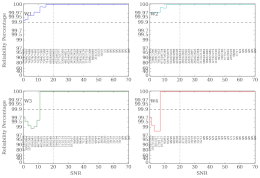 |
| Figure 21a - Differential reliability for the Serpens field after interactive source recovery. | Figure 21b - Cumulative reliability for the Serpens field after interactive source recovery. |
Last update: 2013 October 28


